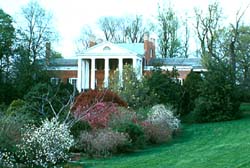
Reston is a census-designated place in Fairfax County, Virginia, United States, and a principal city of both Northern Virginia and the Washington metropolitan area. As of the 2020 U.S. census, Reston's population was 63,226.

Mount Vernon is the former residence and plantation of George Washington, a Founding Father, commander of the Continental Army in the Revolutionary War, and the first president of the United States, and his wife, Martha. An American landmark, the estate lies on the banks of the Potomac River in Fairfax County, Virginia, approximately 15 miles south of Washington, D.C..

Oak Hill is a mansion and plantation located in Aldie, Virginia that was for 22 years a home of Founding Father James Monroe, the fifth U.S. President. It is located approximately 9 miles (14 km) south of Leesburg on U.S. Route 15, in an unincorporated area of Loudoun County, Virginia. Its entrance is 10,300 feet (3,100 m) north of Gilberts Corner, the intersection of 15 with U.S. Route 50. It is a National Historic Landmark, but privately owned and not open to the public.

The George Washington Memorial Parkway, colloquially the G.W. Parkway, is a 25-mile-long (40 km) limited-access parkway that runs along the south bank of the Potomac River from Mount Vernon, Virginia, northwest to McLean, Virginia, and is maintained by the National Park Service (NPS). It is located almost entirely in Northern Virginia, except for a short portion of the parkway northwest of the Arlington Memorial Bridge that passes over Columbia Island in Washington, D.C.
Arthur Cotton Moore was an American architect who was notable for the restoration of Washington Harbour and modernization of the Thomas Jefferson Building.

Hollin Hills is a historic district and neighborhood approximately 10 miles south of Alexandria, Virginia. Though mailing addresses in Hollin Hills are listed as being in Alexandria, it is actually in an unincorporated part of southeast Fairfax County, Virginia. It is located primarily in the Fort Hunt area of the county with some portions remaining in the Hybla Valley and Groveton areas since a shift for census purposes prior to 2010. The community contains more than 30 acres (12 ha) of parkland across seven distinct parks, a pool and swim club, a bocce court, and a pickleball and tennis club, operated and maintained by the Civic Association of Hollin Hills (CAHH).

Fairlington is an unincorporated neighborhood in Arlington County, Virginia, located adjacent to Shirlington in the southernmost part of the county on the boundary with the City of Alexandria. The main thoroughfares are Interstate 395, which divides the neighborhood into North and South Fairlington, State Route 7 and State Route 402.

Woodlawn is a historic house located in Fairfax County, Virginia. Originally a part of Mount Vernon, George Washington's historic plantation estate, it was subdivided in the 19th century by abolitionists to demonstrate the viability of a free labor system. The address is now 9000 Richmond Highway, Alexandria, Virginia, but due to expansion of Fort Belvoir and reconstruction of historic Route 1, access is via Woodlawn Road slightly south of Jeff Todd Way/State Route 235. The house is a designated National Historic Landmark, primarily for its association with the Washington family, but also for the role it played in the historic preservation movement. It is now a museum property owned and managed by the National Trust for Historic Preservation.

Lake Anne is a reservoir in the unincorporated suburban community of Reston in Fairfax County, Virginia, United States. The lake is part of the Difficult Run drainage area of the county.

The Pope–Leighey House, formerly known as the Loren Pope Residence, is a suburban home in Virginia designed by American architect Frank Lloyd Wright. The house, which belongs to the National Trust for Historic Preservation, has been relocated twice and sits on the grounds of Woodlawn Plantation, Alexandria, Virginia. Along with the Andrew B. Cooke House and the Luis Marden House, it is one of the three homes in Virginia designed by Wright.

Charles M. Goodman was an American architect who made a name for his modern designs in suburban Washington, D.C., after World War II. While his work has a regional feel, he ignored the colonial revival look so popular in Virginia. Goodman was quoted in the 1968 survey book Architecture in Virginia as saying that he aimed to "get away from straight historical reproduction."
Henry Wright, was a planner, architect, and major proponent of the garden city, an idea characterized by green belts and created by Sir Ebenezer Howard.

Chloethiel Woodard Smith, was an American modernist architect and urban planner whose career was centered in Washington, D.C. She was the sixth woman inaugurated into the American Institute of Architects College of Fellows and at the peak of her practice led the country's largest woman-owned architecture firm.

Hugh Newell Jacobsen was an American architect. He was noted for designing Jacqueline Kennedy Onassis' home in Martha's Vineyard during the 1980s. He also restored part of the U.S. Embassy in Paris, as well as Spaso House in Moscow.
Hope Park was an 18th and 19th-century plantation in Fairfax County, Virginia, where Dr. David Stuart (1753–1814), an old friend of and correspondent with George Washington lived with his wife, Eleanor Calvert Custis (1758–1811), and family. It was approximately 5 miles (8.0 km) southwest of Fairfax Court House.

Whittemore House is an historic building located at 1526 New Hampshire Avenue, N.W., in the Dupont Circle neighborhood of Washington, D.C. The former private residence, whose previous occupants include a musician, several politicians, and a mountain explorer, now serves as a historic house museum and headquarters of the Woman's National Democratic Club (WNDC).

George Crossman House is an historic home located in the East Falls Church section of Arlington, Virginia. It was built in 1892 by George Grant Crossman for his bride Mary Ellen (Nellie) Dodge of Lewinsville, Virginia. They married on April 7, 1892.

Tauxemont Historic District is a national historic district located near Alexandria, Fairfax County, Virginia. It encompasses 71 contributing buildings, 1 contributing site, and 1 contributing structure in a World War II-era subdivision near Alexandria.

Unitarian Universalist Church of Arlington (UUCA), historically known as the Unitarian Church of Arlington, is a Unitarian Universalist church located at 4444 Arlington Boulevard in Arlington County, Virginia. Founded in 1948, UUCA was the first Unitarian church in Washington, D.C.'s suburbs. Throughout its history, UUCA has taken part in progressive causes from the Civil Rights Movement to the legalization of same-sex marriage in Virginia. During the Civil Rights Movement, UUCA was the only Virginia church to speak out in favor of racial integration. UUCA's sanctuary building, designed by local architect Charles M. Goodman in 1964, is a concrete Brutalist structure that was listed on the National Register of Historic Places and Virginia Landmarks Register in 2014. It is one of only three church buildings designed by Goodman and the only one in Virginia.

Keyes, Lethbridge & Condon was an American architectural firm active, under several different names, in Washington, D.C. from 1951 to 1997. It was founded in 1951 as Keyes, Smith, Satterlee & Lethbridge before splitting into Keyes & Lethbridge and Satterlee & Smith in 1956. Keyes & Lethbridge became Keyes, Lethbridge & Condon in 1958 and Keyes Condon Florance in 1975. After two more name changes it reverted to Keyes Condon Florance in 1995 and was merged into SmithGroup in 1997.






















